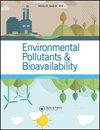Acute toxicity and gene responses induced by endosulfan in zebrafish (Danio rerio) embryos
Q3 Chemical Engineering
引用次数: 20
Abstract
Abstract Endosulfan has been listed as a persistent organic pollutant, and is frequently found in agricultural environments during monitoring processes owing to its heavy use and persistent characteristics. This study was conducted to understand the effects of endosulfan on the development of zebrafish (Danio rerio) embryos by exposing them to a specific range of endosulfan concentrations. Exposing zebrafish embryos to endosulfan for 96 h yielded no acute toxicity until the concentration reached 1500 μg L−1, whereas malformed zebrafish larvae developed severely curved spines and shortened tails. About 50% of zebrafish larvae were malformed when exposed to 600 μg L−1 of endosulfan. Comparative gene expression using real-time quantitative polymerase chain reaction was assessed using endosulfan-exposed zebrafish embryos. CYP1A and CYP3A were significantly enhanced in response to endosulfan treatment. Two genes, acacb and fasn, encoding acetyl-CoA carboxylase b and fatty acid synthase proteins, respectively, were also up-regulated after treating zebrafish embryos with endosulfan. These genes are also involved in fatty acid biosynthesis. The genes encoding vitellogenin and Hsp70 increased in a concentration-dependent manner in embryos. Finally, biochemical studies showed that acetylcholinesterase activity was reduced, whereas glutathione S-transferase and carboxylesterase activities were enhanced in zebrafish embryos after endosulfan treatment. These biochemical and molecular biological differences might be used for tools to determine contamination of endosulfan in the aquatic environment.硫丹对斑马鱼胚胎的急性毒性和基因反应
硫丹已被列为持久性有机污染物,由于其大量使用和持续存在的特点,在农业环境监测过程中经常被发现。本研究旨在了解硫丹对斑马鱼(Danio rerio)胚胎发育的影响,方法是将它们暴露在特定范围的硫丹浓度中。在硫丹浓度达到1500 μg L−1之前,斑马鱼胚胎暴露于硫丹96 h不会产生急性毒性,而畸形斑马鱼幼虫则出现严重的脊柱弯曲和尾巴缩短。当暴露于600 μg L−1硫丹时,约50%的斑马鱼幼鱼畸形。采用实时定量聚合酶链反应对暴露于内源性磺胺的斑马鱼胚胎进行比较基因表达评估。CYP1A和CYP3A对硫丹治疗的反应显著增强。在硫丹处理斑马鱼胚胎后,分别编码乙酰辅酶a羧化酶b和脂肪酸合成酶蛋白的acacb和fasn基因也出现了上调。这些基因也参与脂肪酸的生物合成。卵黄原蛋白和Hsp70编码基因在胚胎中呈浓度依赖性增加。最后,生物化学研究表明,硫丹处理后的斑马鱼胚胎乙酰胆碱酯酶活性降低,而谷胱甘肽s -转移酶和羧酸酯酶活性增强。这些生物化学和分子生物学上的差异可以作为确定水生环境中硫丹污染的工具。
本文章由计算机程序翻译,如有差异,请以英文原文为准。
求助全文
约1分钟内获得全文
求助全文
来源期刊
CiteScore
1.62
自引率
0.00%
发文量
0
审稿时长
1 months
期刊介绍:
Chemical Speciation & Bioavailability ( CS&B) is a scholarly, peer-reviewed forum for insights on the chemical aspects of occurrence, distribution, transport, transformation, transfer, fate, and effects of substances in the environment and biota, and their impacts on the uptake of the substances by living organisms. Substances of interests include both beneficial and toxic ones, especially nutrients, heavy metals, persistent organic pollutants, and emerging contaminants, such as engineered nanomaterials, as well as pharmaceuticals and personal-care products as pollutants. It is the aim of this Journal to develop an international community of experienced colleagues to promote the research, discussion, review, and spread of information on chemical speciation and bioavailability, which is a topic of interest to researchers in many disciplines, including environmental, chemical, biological, food, medical, toxicology, and health sciences.
Key themes in the scope of the Journal include, but are not limited to, the following “6Ms”:
Methods for speciation analysis and the evaluation of bioavailability, especially the development, validation, and application of novel methods and techniques.
Media that sustain the processes of release, distribution, transformation, and transfer of chemical speciation; of particular interest are emerging contaminants, such as engineered nanomaterials, pharmaceuticals, and personal-care products.
Mobility of substance species in environment and biota, either spatially or temporally.
Matters that influence the chemical speciation and bioavailability, mainly environmentally relevant conditions.
Mechanisms that govern the transport, transformation, transfer, and fate of chemical speciation in the environment, and the biouptake of substances.
Models for the simulation of chemical speciation and bioavailability, and for the prediction of toxicity.
Chemical Speciation & Bioavailability is a fully open access journal. This means all submitted articles will, if accepted, be available for anyone to read, anywhere, at any time. immediately on publication. There are no charges for submission to this journal.

 求助内容:
求助内容: 应助结果提醒方式:
应助结果提醒方式:


